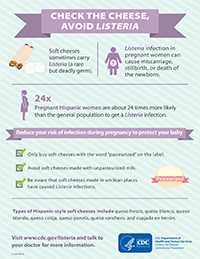Information for Health Professionals and Laboratories
Technical Information
Clinical Features
The clinical features of listeriosis depend on the patient.
In older adults and people with immunocompromising conditions, the most common clinical presentations are invasive infections, such as sepsis, meningitis, and meningoencephalitis. People can also experience focal infections, including septic arthritis, osteomyelitis, prosthetic graft infections, and infections of sites inside the chest and abdomen or of the skin and eye. Less commonly, otherwise healthy young people may also develop invasive listeriosis.
Listeriosis during pregnancy is typically a relatively mild “flu-like” illness. Some pregnant women with Listeria infection have no symptoms. Although severe disease in the mother is rare, infection during pregnancy can result in miscarriage, stillbirth, preterm labor, and sepsis or meningitis in the neonate.
- Some neonates with listeriosis develop granulomatosis infantiseptica, a severe disorder involving the internal organs and skin.
- Neonatal listeriosis is classified as early (within 6 days of birth) or late onset (7–28 days after birth).
- Early-onset neonatal listeriosis is usually acquired through transplacental transmission.
- The sources of late-onset listeriosis are less clear; they may involve exposure during delivery or nosocomial exposure.
People with normal immune systems rarely develop invasive infection. However, they may experience a self-limited acute febrile gastroenteritis following high-dose Listeria exposure. Because Listeria cannot be detected by routine stool culture, febrile gastroenteritis from Listeria infection is rarely diagnosed outside of outbreak settings.
Information about the management of patients who report eating a food that may have been contaminated with L. monocytogenes is available below.
Patient management
This section presents a framework for assessment and medical treatment of high-risk people (pregnant women, older adults, and people with weakened immune systems) who may have been exposed to L. monocytogenes by eating contaminated foods.
The risk of invasive listeriosis after exposure to L. monocytogenes is very low; exposure is common, but disease is rare. A study related to a 2011 outbreak linked to cantaloupe estimated the attack rate at roughly 1 case per 10,000 pregnant women who ate the implicated cantaloupe.
Management of pregnant women: The American College of Obstetrics and Gynecology has issued a committee opinion on the Management of Pregnant Women with Presumptive Exposure to Listeria monocytogenes.
Management of people other than pregnant women with elevated risk of invasive listeriosis: Clinicians may consider using the framework below. This framework is not intended either as a practice guideline or as a modification of existing guidelines or practices in managing patients with confirmed or suspected listeriosis. Little scientific evidence is available to inform decisions regarding management of people at elevated risk of invasive listeriosis who have been exposed to L. monocytogenes and who are either asymptomatic or have mild symptoms that could be consistent with early Listeria infection. Therefore, this suggested framework is based on informal solicitation of experts in infectious disease, obstetrics and gynecology, and public health in 2011. Patient management decisions for asymptomatic or mildly symptomatic people are appropriately made on a case-by-case basis, informed by clinical judgment and the likelihood of exposure of the patient. Consultation with a specialist in infectious disease may be considered.
- Exposed, asymptomatic: Most experts believe that no testing or treatment is indicated for an asymptomatic person with elevated risk of invasive listeriosis who ate a product recalled because of L. monocytogenes contamination. Such a patient should be instructed to return for medical treatment if he or she develops symptoms of listeriosis within two months after eating the recalled product. Symptoms may include fever and myalgias, often preceded by diarrhea or other gastrointestinal symptoms. In older adults and immunocompromised people, symptoms of listeriosis can include headache, stiff neck, confusion, loss of balance, and convulsions.
- Exposed, afebrile, mild symptoms: A person with elevated risk of invasive listeriosis who ate a product recalled because of L. monocytogenes contamination, who is afebrile and has signs and symptoms consistent with a minor gastrointestinal or flu-like illness, such as mild myalgias or mild nausea or diarrhea, could be managed expectantly; this approach limits low-yield testing. Alternatively, such a patient could be tested with blood culture. If diagnostic tests are performed, some experts would withhold antibiotic therapy unless cultures yielded L. monocytogenes. Others would initiate antibiotic therapy while culture results were pending and then stop treatment if the cultures were negative. The antibiotic regimen could consist of oral ampicillin or amoxicillin, although it is important that both the clinician and the patient know that no effectiveness data exist for this scenario. If the blood culture yielded Listeria, standard antimicrobial treatment for listeriosis, typically including IV ampicillin and gentamicin, would be indicated.
-
Exposed, fever and symptoms consistent with invasive listeriosis: An exposed person with elevated risk of invasive listeriosis with fever (>100.6° F, >38.1° C) and signs and symptoms consistent with listeriosis, for whom no other cause of illness is known, should be tested and treated for presumptive listeriosis.
- Diagnostic testing should include blood culture and other tests, such as culture of cerebrospinal fluid, as indicated by the clinical presentation.
- The antimicrobial regimen should be the standard therapy for listeriosis, typically including IV ampicillin and gentamicin for 14 to 21 days for nonallergic patients.
- If blood culture is negative and symptoms resolve, antibiotic therapy may be discontinued.
- Exposed, history of symptoms in past 4 weeks, currently asymptomatic: Most experts believe that no testing or treatment is indicated for an asymptomatic person with elevated risk of invasive listeriosis who ate a product recalled because of L. monocytogenes contamination and experienced symptoms that have resolved. Any such patient should be instructed to return for medical care if he or she develops symptoms of listeriosis within 2 months after eating the recalled product.
Note: The suggested framework above does not include stool culture for L. monocytogenes. Stool culture has not been evaluated as a screening tool and is not recommended for the diagnosis of listeriosis. Ingestion of food contaminated with Listeria occurs frequently because the bacterium is commonly present in the environment. Therefore, intermittent fecal carriage and shedding of Listeria is also frequent (about 5% in unselected populations, but substantial variation exists) and rarely indicative of infection. Stool culture for Listeria may also have low sensitivity and is rarely available in clinical laboratories. Serologic testing for Listeria has poor sensitivity and specificity and is not recommended for diagnosis of listeriosis in individual patients.
Etiologic agent
Listeria monocytogenes is a facultatively anaerobic, rod-shaped, gram-positive bacterium that can be readily isolated in standard bacterial culture of normally sterile body sites. It is widespread in the environment and can be isolated from soil, water, and decaying vegetation. It is a hardy organism that can withstand a wide range of conditions including freezing, drying, heat, and relatively high levels of acid, salinity, and alcohol. Unlike most foodborne pathogens, it can grow at standard refrigerator temperature (40°F), which makes it a particular problem in ready-to-eat foods that are not cooked before eating.
Serotyping differentiates isolates of Listeria below the species level. Listeria serotypes are designated based on the immunoreactivity of two cell surface structures, the O and H antigens. Twelve serotypes of L. monocytogenes (1/2a, 1/2b, 1/2c, 3a, 3b, 3c, 4a, 4b, 4c, 4d, 4e, and 7) are recognized, three of which (1/2a, 1/2b, and 4b) cause most (95%) human illness; serotype 4b is most commonly associated with outbreaks.
Incidence
The annual incidence of laboratory-confirmed listeriosis in the United States is about 0.24 cases per 100,000 population, based on active surveillance in 10 FoodNet sites. The U.S. Healthy People 2020 target for listeriosis is 0.2 cases per 100,000.
Approximately 800 laboratory-confirmed cases are reported annually to CDC’s National Notifiable Disease Surveillance System. However, many cases are not detected or reported, and CDC’s 2011 Estimates of Foodborne Illness, which includes estimates of cases not diagnosed or reported, indicates that approximately 1,600 cases occur annually in the United States.
Outcomes
CDC estimates that listeriosis is the third leading cause of death from foodborne illness with about 260 deaths per year. Nearly everyone with listeriosis is hospitalized. The case-fatality rate is about 20%. Nearly one-quarter of pregnancy-associated cases result in fetal loss or death of the newborn.
Transmission
Listeriosis is usually acquired through foodborne transmission, except for fetal and neonatal infection, which is usually acquired in utero. Cutaneous infections have been reported very rarely among veterinarians and farmers following direct animal contact, particularly involving livestock products of conception.
Risk groups
Older adults, people with weakened immune systems, and pregnant women and their newborns are at highest risk of listeriosis. Otherwise healthy young people only rarely develop invasive listeriosis.
Surveillance
For more than 30 years, CDC has conducted surveillance for Listeria infections to learn more about the germ, how it causes disease, how it’s spread, and other information to help protect the public from illness.
- The Listeria Initiative: Provides a look at the “who, where, and when” of Listeria infections >
- Foodborne Diseases Active Surveillance Network (FoodNet): Provides data on the incidence of Listeria infections >
- PulseNet: Connects cases using DNA ‘fingerprinting’ of the bacteria that make people sick >
- National Notifiable Diseases Surveillance System: Monitors nationally notifiable diseases and conditions >
- Foodborne Disease Outbreak Surveillance System: Collects reports of foodborne disease outbreaks >
Trends
Listeria was first recognized as a foodborne pathogen in the 1980s, and the incidence was first estimated at about 0.8 cases per 100,000 in the late 1980s. By the early 2000s, listeriosis incidence had declined to about 0.3 cases per 100,000. Since then, listeriosis incidence has remained largely unchanged.
Patient Education
Food safety brochures

FDA brochure series for at-risk groups:
- Guide for Food Safety for Older Adults [PDF – 26 pages]
- Guide for Food Safety for People with Cancer [PDF – 26 pages]
- Guide for Food Safety for People with Diabetes [PDF – 26 pages]
- Guide for Food Safety for People with HIV/AIDS [PDF – 26 pages]
- Guide for Food Safety for Pregnant Women [PDF – 26 pages]
- Guide for Food Safety for Transplant Recipients [PDF – 26 pages]
- Informational poster with ordering information [PDF – 1 page]
Information for pregnant women about soft cheeses
Fotonovela
While Pregnant, Be Careful with Queso Fresco

Poster
Beware of Queso Fresco!

8″x11″ [PDF – 1 page]
11″x17″ [PDF – 1 page]
24″ x 36″ [PDF – 1 page]
Community educator’s guide
FDA community educator’s guide
More resources

More risk reduction and food safety resources can be found on the following pages:
Guidelines for Submitting a Listeria Specimen to CDC
CDC offers confirmatory identification and subtyping of Listeria species recovered from normally sterile sites.
- Learn who may submit a specimen
- Select a test order
- Download a submission form
- Find packing and shipping instructions
- Learn how to avoid time-consuming errors with our training materials
- Get answers to commonly asked questions
NOTE: CDC accepts specimens for analysis only from state public health laboratories and other federal agencies. Private healthcare providers and institutions must submit specimens to their state public health laboratory for processing.
- Page last reviewed: December 12, 2016
- Page last updated: June 29, 2017
- Content source:


 ShareCompartir
ShareCompartir
